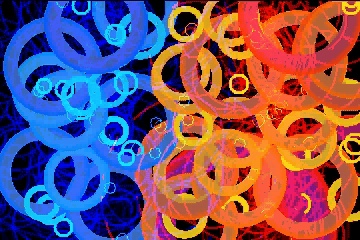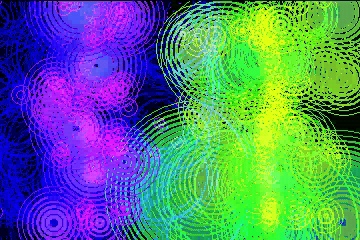
Multimedia
woony.home
Woonogram




Woonogram is a sound visualization mapping scheme that generates animations of polygons from the spectral information of sound. Although based on a set of simple rules, it produces evocative animation of sound through spectral analysis while providing flexibility and variety
thorugh simple changes of parameters.
Sonoglyph of Half-life
- Premiered at the CREATE concert, Nov 15, 2001.
- Featured in the Point Line Cloud DVD
- Music: Sonal Atoms - part 1 of Half-Life by Curtis Roads
- Visualization by Woon Seung Yeo (2001)
- Video Excerpt (27.6 MB, 1:18)
The imagery consists of a creative mathematical mapping of the sonic energy of the piece into an evocative computer-generated animation.
Fono
- Performed at the CCRMA@CNMAT concert, May 15, 2005.
- Submitted to the Seoul International Computer Music Festival 2005.
- Music by Rodrigo Segnini
- Visualization by Woon Seung Yeo (2005)
- Video (159.5 MB, 8:20)
The human voice is a universal mode of sound generation for which everyone can be considered a virtuoso, not so much for what we say with it, but for our ability to control it and produce with it a great variety of sounds. Fono takes as point of departure the story of a computer that would like to learn how to sing, as a metaphor to study of some of its qualities. Sinusoidal sounds constitute the basic sound material, and granular synthesis and markov models are used to control structure and form. It was composed entirely using Common Lisp Music (CLM).
Animation of Fono is created by Woonogram, a Matlab based sound visualization tool written by Woon Seung Yeo. Based on a set of simple rules, it maps spectral data of sound to various geometric settings of polygons and produces evocative motions, while providing enough flexibility through controls of parameters. Fluctuating level of correlation between sound and movie suggests the imperfect singing, and the struggling effort, of the computer.
Animation of Fono is created by Woonogram, a Matlab based sound visualization tool written by Woon Seung Yeo. Based on a set of simple rules, it maps spectral data of sound to various geometric settings of polygons and produces evocative motions, while providing enough flexibility through controls of parameters. Fluctuating level of correlation between sound and movie suggests the imperfect singing, and the struggling effort, of the computer.
Checkmate


- A chess music performance by Rodrigo Segnini and Woon Seung Yeo
- Performed at the MusiCollage: A Happening by CCRMA and Friends, March 8, 2005.
In a chess game, the importance of a piece is circumstantial. While a queen or a tower are ranked higher for its potential in terms of reach, a pawn, more limited in its movements can still be decisive due to its location at a particular time in the game. Thus, it can be said that the player's intention is what singularizes a piece, and given the effect of their interaction in any pre-formulated plans, the state of the game also becomes a factor. This framework results in an equalizer of sorts, where every piece waits for its time and the player's intent to acquire its real personality.
CheckMate explores this scenario by producing music related to the intention of the dancers and their movements. The sound's dimensions will vary according to each piece and the state of the game. Images are also projected following the same rules, not necessarily in concordance with the audio. These relationships are controlled live by the composers on stage. As in chess, this approach can prove a deceitful strategy; intent, if well hidden, can be a terrific weapon and then it is too late... check mate.
CheckMate is inspired by Reunion, a collaborative performance spearheaded by John Cage in 1968 where he and others, including Marcel Duchamp, played a kind of sonified chess in front of an audience.
1-2 composers with laptop(s) on stage or a vantage position therefrom with audio (multichannel if possible) and video outputs. 2-32 dancers (black & white coloring suggested); their participation should reflect an understanding of the purposes and the inspiration source stated in the program above.
CheckMate explores this scenario by producing music related to the intention of the dancers and their movements. The sound's dimensions will vary according to each piece and the state of the game. Images are also projected following the same rules, not necessarily in concordance with the audio. These relationships are controlled live by the composers on stage. As in chess, this approach can prove a deceitful strategy; intent, if well hidden, can be a terrific weapon and then it is too late... check mate.
CheckMate is inspired by Reunion, a collaborative performance spearheaded by John Cage in 1968 where he and others, including Marcel Duchamp, played a kind of sonified chess in front of an audience.
1-2 composers with laptop(s) on stage or a vantage position therefrom with audio (multichannel if possible) and video outputs. 2-32 dancers (black & white coloring suggested); their participation should reflect an understanding of the purposes and the inspiration source stated in the program above.